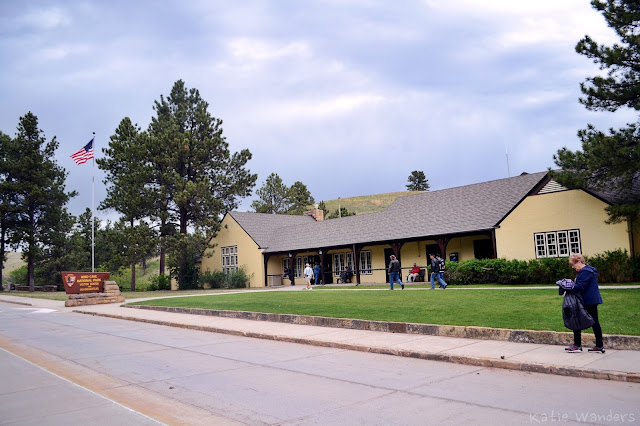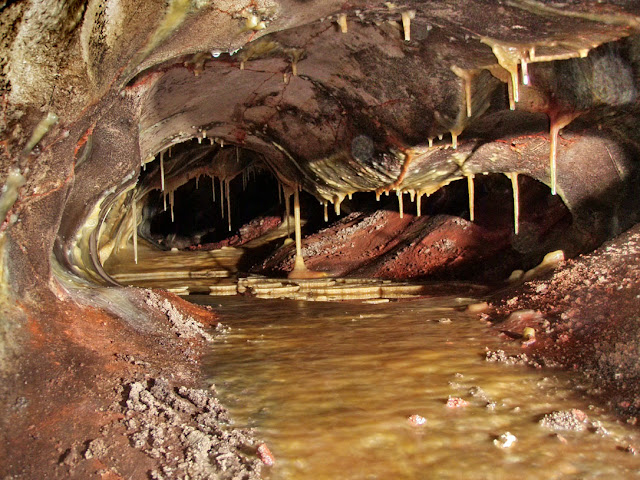It's been a crazy few weeks. Between packing, loading a moving truck, driving across the country, unloading a moving truck and unpacking. Let's just say that I went to bed at 8:30 pm last night from all the emotions, stress, and physical effort of this haul. I am so excited to recap my trip across the country and wanted to start with a few of my favorite stops along the way. And then we will fill in the gaps, I promise! But the first big stop I am sharing with you today is Wind Cave National Park in Hot Springs, South Dakota.

I have to admit, I had never heard of Wind Cave National Park. Not even once. Living in Utah, you get so used to having five amazing National Parks right in your back yard. In New England, we are pretty limited to the awesome, but one national park Acadia in Bar Harbor, Maine. It wasn’t until the day before my trip, when looking at routes to Mount Rushmore National Monument that I noticed Wind Cave National Park sat an hour south.
 |
| NPS.org Map of Wind Caves |
Wind Cave National Park is a relatively small National Park (28,294 acres) and sits in a busy corner of South Dakota. Within 50 miles of Wind Cave there are two National Park System areas: Jewel Cave National Monument with more than 125 miles of caves to the northwest, and Mount Rushmore National Memorial to the north. There is also the adjacent Black Hills National Forest all along the west of the park, and Custer Start Park abutting the park to the north. Rapid City is to the far north, and Hot Springs to the south. You can find lakes and reservoirs, hiking and biking, and campgrounds. A trip to Wind Caves warrants a trip to all of these awesome gems of South Dakota. So now that we are familiar with the area (and this was a huge educational/geography lesson for me), let's talk a little about the park.
 |
| Posing with the entrace sign |
First Impressions: Small National Park but full of charm and history. It is also relatively dog-friendly with a few of the trails (and picnic area!) open to dogs. Dogs are not allowed in the visitor's center or in the caves. The park was beautiful with grasslands, ponderosa pine, bison and prairie dogs running around. I am pretty disappointed I did not get to tour the cave as it looked like an awesome experience. Book your tickets early to tour the cave.
Fees: First off, this National Park is Free*. While there is a fee to tour the cave, there is no entrance fee to enter the park or to use its trails and picnic areas. The visitors center offers great exhibits about the park, as well as restrooms, vending machines, a store, ad most importantly, cave tour and tickets for the tours.
 |
| Visitor's Center Wind Caves National Park |
Camping: Elk Mountain Campground has 75 sites of tents and recreational vehicles and is open from April through October (first come, first served). You can find iconic tables, fire grills, water and restrooms, and there is a fee to use the campground. Backcountry camping is allowed with a permit.
 |
| Following the trails (some are dog friendly!) |
Trails: While there aren’t a ton of trails here, there are three self-guided trails where you can explore the park’s grassland and ponderosa pine forests. Rankin Ridge Trail (1.25 miles) climbed to the highest point in the park for panoramic views of the Black Hills. Elk Mountain Trail (1 mile) is a walk circling the campground. Hikers are also allowed to travel and explore 30 miles of hiking trails that include the “southern terminus of the 111 mile Centennial Trail”. You can also find some other hiking trails listed on the map.
Drive: There is a scenic drive (route 385 and route 87) going right through the western border of the park We entered Gobbler Pass, the southern entrance to the park, and drove 385 all the way up to the visitor center, stopped in the picnic area, and back up and out 385. The drive does continue north to Eoute 87 to other scenic overlooks in the park, and to Lookout Tower (5,013’) and the Rankin Ridge trail. You can also follow 87 north into Custer State Park.
 |
| Cave Tour at Wind Caves National Park |
 |
| NPS.org: Cave Tour at Wind Caves National Park |
 |
| Map of inside the Wind Cave |
Cave Tours: All visits to the cave are via scheduled a ranger-led tours. The tours are offered all year round (except the days the visitors center is closed, Christmas and New Years Day) There are more than 100 miles of known passage throughout Wind Cave. There are three tours available: Tour 1: The Natural Entrance Tour (red below) and Tour 2: Fairgrounds Tour (gold below) last 1.25 to 1.5 hours and required about 300 to 450 stairs. Tour 3: The Garden of Eden Tour (green below) lasts about one hour and includes 150 stairs. These tours follow paved and lighted walkways through underground passages decorated with box work and other formations.
There are two special tours offered from Mid June to Mid August the one mile Candlelight Tour (purple) two hour tour and the Caving Tour (blue) through a wild 3,000’ passage (three to four hour trip) * * Reservations for special tours are required and can be made no sooner than one month in advance. Also note to buy tickets for the regular cave tours EARLY as when we were there, tours were virtually sold out for the day. Also note, that the cave temperature is ALWAYS 53 degrees F so bring something warm to wear. In the cave, you can expect to see features such as flowstone, stalactites, stalagmites, elk rooms, box work ceilings, popcorn, and frostwork.
 |
| Wind Cave Park History |
History: There are a few things that make this park so unique and spectacular. First and foremost is obviously the cave. Second, it is the parks history. The Wind Cave Area has been protected since 1903 when it became the seventh oldest National Park. Regarded as sacred by American Indians, the cave was not found by settlers until 1881, when two brothers (Jesse and Tom Bingham) heard a loud whistling noise that led them to a small hole in the ground, the dates ONLY natural opening. The wind was said to blow with such force out of the hole that it knocked Jesse’s hat right off. This wind gave the park and cave its name, and is created by differences in atmosphere pressures in and out of the cave. The wind can still be noticed at the cave entrance. Turns out, this is one of the world’s oldest caves, and according to barometric wind studies, approximately only five percent of the dave has been discovered.
 |
| Bison at Wind Caves National Park |
 |
| Pronghorn by the entrance sign to Wind Caves National Park |
About the park/Critters: Driving around the park, you have to love the names as you drive around. You drive through "Bison Flats" and "Windy Point", past "Prarie Dog Canyon”. And I have to say, these names did not disappoint. At the entrance sign we saw this pronghorn (above) posing near the sign. No less than five minutes after we drove into the park entrance and “Bison Flats” we were created with a large bison, posing alongside the road right across from a pullout area. We then stopped to look around and see hundreds of tiny “mole hill” looking sand piles strewn all across the landscape. I looked closer to see tiny prairie dogs running across the landscape. Now I have never seen a prarie dog before but I was beyond giddy to see these adorable critters scampering across the park. These are "Black Tail Prarie Dogs" and you can read more about them here. Basically, there are tons of them and the mounds of dirt beside their hole builds a dam and marks their post. These little mounds create towns, and they are just adorable. Don't get too close as they do bite, and carry fleas that carry the plague. Rattlesnakes and black widow spiders also use the burrows for their homes. And because you need ONE MORE fun prarie dog fact "Prairie dogs eat grass and keep it cropped short so that they may have an unobstructed view of approaching predators".
While the park’s original intention was to protect the cave, soon enough, it became equally as important to protect the wildlife within the park. The park serves as a sanctuary to restore populations of bison, elk, and pronghorn to the Black Hills that were eliminated from this part of their range in the late 1880s due to humans. The park started with 14 bison in 1913 donated by the Bronx Zoo and now has a herd of 350 today. We saw pronghorn, prairie dogs, and bison right away. You can also find coyotes, mule deer, and various birds, cottontail rabbits, and smaller mammals.
While the park’s original intention was to protect the cave, soon enough, it became equally as important to protect the wildlife within the park. The park serves as a sanctuary to restore populations of bison, elk, and pronghorn to the Black Hills that were eliminated from this part of their range in the late 1880s due to humans. The park started with 14 bison in 1913 donated by the Bronx Zoo and now has a herd of 350 today. We saw pronghorn, prairie dogs, and bison right away. You can also find coyotes, mule deer, and various birds, cottontail rabbits, and smaller mammals.
 |
| Landscape at Wind Caves National Park |
Next Stop: Mount Rushmore National Monument!


I remember visiting there a few years ago - I thought it was interesting! Nice pics! - Alicia @ www.girlonahike.com
ReplyDelete